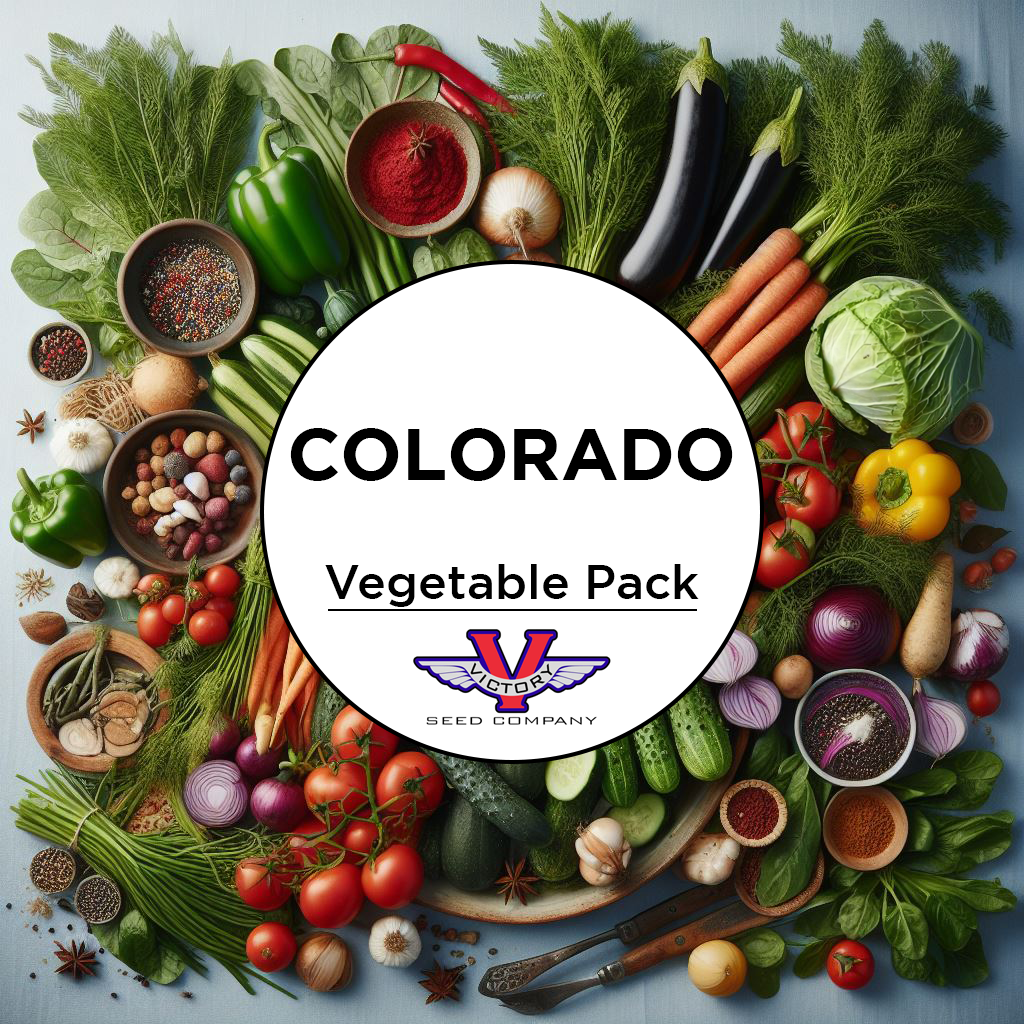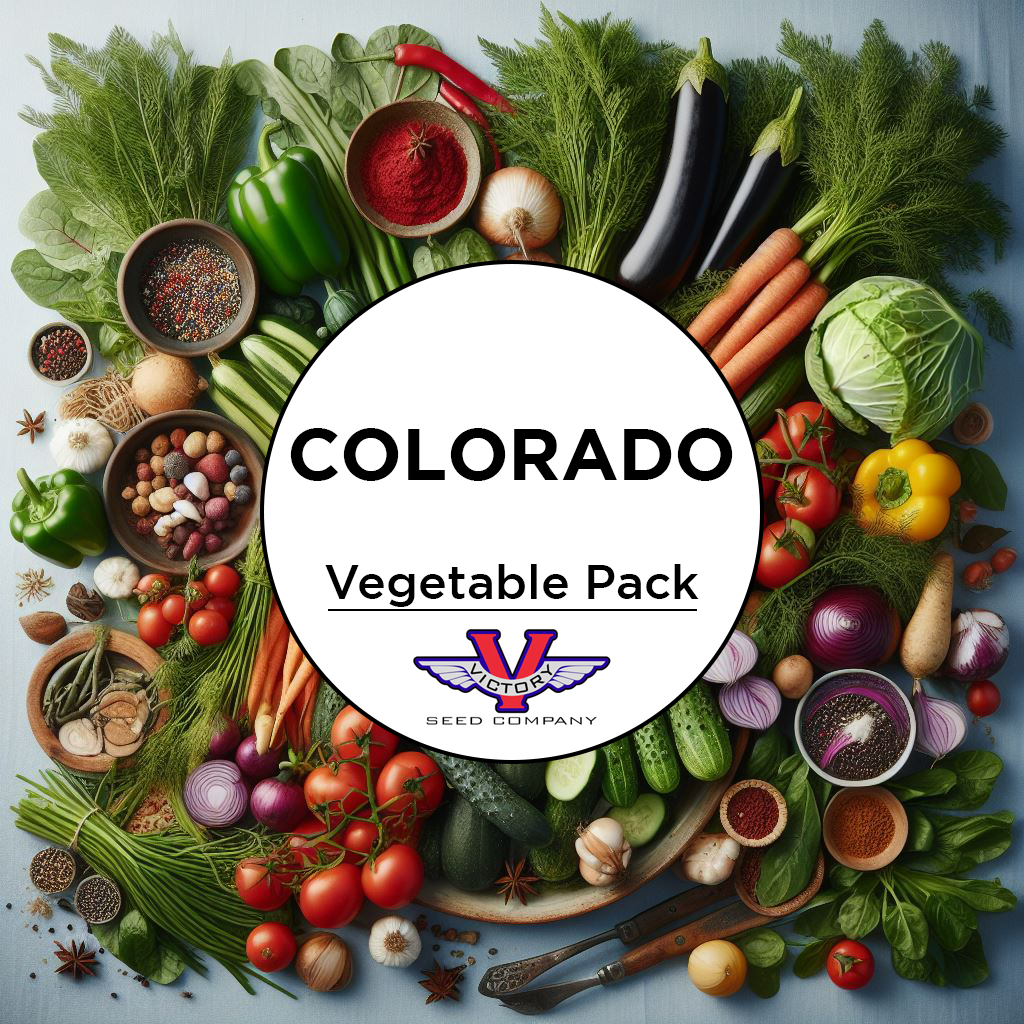Colorado Vegetable Garden Pack
Colorado Vegetable Garden Pack
Couldn't load pickup availability
Place a single order for this item and you will get one packet of each of the items shown below at an overall discount. If you prefer, you can order them individually one by one, by clicking on each item in the list.
 Basil, Italian Large Leaf (Sweet)
Basil, Italian Large Leaf (Sweet)Germination: 5 to 7 days A native to Europe and cultivated for centuries as a fresh and dried culinary herb. Common in America by the late 1700s. The plants grow to about eighteen inches, and provide several harvests. The leaves are used fresh to make pesto, and can be dried and used as a seasoning. A favorite in Italian dishes. Prefers well-drained soil, even moisture, and full sun.
 Scarlet Runner Bean
Scarlet Runner BeanGrown in the United States as early as 1750, it is vigorous and prolific with beautiful, bright-red colored blooms displayed throughout the summer. The vines can grow to 18-feet in length so a good, sturdy support structure is required. Use string or twine as wire will heat and burn the tender vines. Although it is good all-purpose bean that can be enjoyed harvested young as a snap bean, used as a shelled bean, or left on the vines and harvested as a dry bean.
 Detroit Dark Red Beet
Detroit Dark Red BeetVery tasty fresh out of the garden, it also maintains its taste and texture well after being canned or pickled. Globe shaped, excellent color, sweet, smooth and tender.
 Di Ciccio Broccoli
Di Ciccio BroccoliAn old European variety Introduced in 1890. Compact, 2 to 3 feet high plants, that produce a central 3 to 4 inch head with many side shoots. Freezes well.
 Catskill Brussels Sprouts
Catskill Brussels SproutsThe 20 to 24 inch tall plants produce heavily. The sprouts are large (up to 1¾ inches), dark-green and firm. Used for fall harvests, it is good fresh or frozen. Developed in 1941.
 All Seasons Cabbage
All Seasons CabbageAlso known as 'Vandergaw', this variety is heat resistant, fine-flavored and produces good, hard heads that are ten inches in diameter, average about 12 pounds and are round but flattened on top. Released in 1886.
 Shin Kuroda Carrot
Shin Kuroda CarrotBright orange roots are 5 to 6 inches long, stump-rooted, tender and sweet. Popular Asian market variety. Good for home garden and excellent as juicer. Very good storage carrot.
 Snowball Self-Blanching Cauliflower
Snowball Self-Blanching CauliflowerA snowball-type with leaves that curl in the cool fall weather and cover the head to keep the white color. They do not require tying until the heads are six to eight inches across.
 Perpetual Swiss Chard
Perpetual Swiss ChardLeaves are smooth, dark-green in color with fine midribs. It is very vigorous and provides an almost "perpetual" harvest. If you garden in an area with a hot climate, it is a great choice for a continuous supply of tasty summertime greens.
 Champion Collards
Champion CollardsStart harvesting individual leaves at about 65 days from planting. The leaves become tough with age. Used as a boiled green with a cabbage-like flavor. Hardy, widely adapted, dark blue-green leaves on thirty inch plants.
 Golden Bantam Sweet Corn
Golden Bantam Sweet CornThe plants grow to about six feet and produce seven inch ears loaded with eight rows of sweet, plump, golden kernels. Bred by a farmer named William Chambers of Greenfield, Mass. Introduced by W. Atlee Burpee in 1902. Prior to this introduction, people thought that yellow corn was fit only for animal feed.
 Boston Pickling Improved Cucumber
Boston Pickling Improved CucumberOriginally released about 1880, it is a dependable variety that bears over a long period of time if kept picked. This improved strain is disease resistant. The plants have blocky, bright green fruits that are perfect for pickling.
 Big Max Pumpkin
Big Max PumpkinThe bright yellow orange flesh is three to four inches thick. Suitable for pies. They will commonly grow to fifty to seventy pounds and with some attention, will surpass one hundred pounds. Big Max needs plenty of room to grow.
 Honeynut Winter Squash
Honeynut Winter SquashCreated as an interspecies cross between butternuts (C. moschata) and buttercups (C. maxima), this interesting cultivar has good levels of resistance to powdery mildew and produces 4-5" miniature butternuts with dark, extra healthy flesh, with much higher levels of beta carotene and Vitamin A than other squashes. The fruit remains green all the way until ripening to orange in the last couple weeks.
 Early Prolific Straightneck Summer Squash
Early Prolific Straightneck Summer SquashBest harvested (our opinion) when the fruit is five to six inches long and still tender. Mature size is 12 to 14 inches.
 Dark Green Zucchini Summer Squash
Dark Green Zucchini Summer SquashHarvest when the fruit is six to eight inches long or still tender. Harvest will be lengthened if you keep picking. As the season gets in full gear, you should have plenty to give away. But if you want the gesture to be appreciated, three small fruits with a couple of tomatoes will be better than a shopping bag full of monster-sized ones!
 Diamond Eggplant
Diamond Eggplant70 days — Diamond Eggplant is a beautiful and versatile variety of eggplant that produces large (6-9 inch), deep purple fruits that are glossy and smooth. This eggplant variety is prized for its sweet and delicate flavor, making it a favorite among gardeners and chefs alike.
 Arugula
ArugulaAlso known as rocket or roquette and is popular in Italian cuisine. Adds an interesting tangy flavor to an otherwise bland salad. All plant parts are edible and harvest is enjoyed over a long period as it is a cut and come again plant.
It prefers cool weather so start sowing successive plantings directly in the garden as soon as the soil can be worked in the spring. Also try an early to mid-fall planting in a cold frame or greenhouse for harvest throughout the winter.
Sow seed ¼ inch deep in a location that receives full sun to partial shade. Best soil temperatures for germination is 40 to 50ºF. Sow about one inch apart thinning plants to a spacing of about six inches. Harvest when the leaves are 2 to 3 inches long.
 Bouquet Dill
Bouquet DillGermination - 7 to 10 days Planting Depth - ¼ inch Seed Spacing - 1 inch Row Spacing - 24 inches Spacing after Thinning - 8 inches Sow in average soil after all danger of frost has passed. Harvest while the flowering heads are still green. Pull plant, roots and all. Use fresh or hang upside down in a dark and dry location until completely dry. Seeds and leaves are also used dried as a culinary herb. Fine, tender parts are finely chopped and added to sauces. Also used fresh in pickling.
 Dwarf Blue Curled Scotch Kale (Vates)
Dwarf Blue Curled Scotch Kale (Vates)The leaves are finely curled, bluish green, low growing at twelve to fifteen inches tall with a spread of twenty four to thirty inches. It stands well and is hardy.
 All The Year Round Butterhead Lettuce
All The Year Round Butterhead LettuceMedium-sized heads stay firm and solid even in hot weather. Can be sown in most locations from about March through August for a nearly "year-round" harvest periods. It does well in both hot and cooler locations.
 Parris Island Cos Romaine Lettuce
Parris Island Cos Romaine LettuceUniform heads are tall and erect. Interior is pale-green to cream and the outer leaves are dark, gray, green. Developed by the USDA and Clemson Agricultural Experimental Station. Released in 1951.
 Honey Rock Melon
Honey Rock MelonThe fruits are up to 6 inches in diameter with a tough, coarsely netted skin and sweet, flavorful salmon colored flesh. The plants are vigorous, produce 5 to 7 fruits per plant and are disease resistant. Introduced in about 1920.
 Perkins' Long Pod Okra
Perkins' Long Pod Okra'Perkins Long Pod' is a good choice for pickling, canning, and used in soups and gumbo.
 Warrior Bunching Onion
Warrior Bunching OnionWarrior Bunching Onion is an easy-to-grow, low-maintenance variety that can be grown year-round in most regions. It is a hardy plant that can withstand cold temperatures and is also resistant to diseases.
 Italian Parsley
Italian ParsleyPlants have deeply cut, dark green leaves with a rich, strong flavor; generally stronger in flavor than the curled types. Excellent for flavoring. Parsley has been cultivated for centuries and is used as a garnish, palate cleanser, flavoring in soups, salads, as a seasoning in other recipes, and medicinally.
 Sugar Snap Pea
Sugar Snap PeaYoung pods are tasty and tender but develop strings at maturity. Vines can reach 6 feet and need trellised. Freezes well but will not stand up to canning temperatures. Released and an " All-American Selection®" winner in 1979.
 Golden California Wonder Bell Pepper
Golden California Wonder Bell PepperThe plants are upright, strong, and produce 4 or 5 fruits that are mostly four-lobed, blocky, and 4 by 4½ inches with thick flesh that is mild and sweet. The skin is a bright gold, changing to orange-red when mature.
 Jalapeno Hot Pepper
Jalapeno Hot PepperThe fruit are dark green, tapered, three inches by one inch, turning red when mature. Good for pickling or used fresh in salsas. They have thick walls so do not dry well. They can range from 2,500 to 10,000 Scoville units in heat.
 Pink Beauty Radish
Pink Beauty RadishThe round globes of 'Pink Beauty' can grow large but still remain crisp, mild and not pithy. The flesh is bright white while the skin is an attractive pink color that makes it an interesting addition to a tossed salad or vegetable platter.
 Bloomsdale Longstanding Spinach
Bloomsdale Longstanding SpinachLeaves are dark green and crumpled. Stands well in hot weather. Named after their farm in Bristol, PA, D. Landreth & Co. released ‘Bloomsdale’ in the 19th century. 'Long Standing Bloomsdale' was developed and introduced in 1925 by Zwaan and Van der Molen, Voorburg, Netherlands.
 Sunflower, Giant Greystripe
Sunflower, Giant GreystripePlanting Instructions: Sunflowers are very easy to grow and because of their size, quite spectacular for a child’s garden. Sow directly outdoors, ¾ inches deep. Thin the plants at first to 8 inches and then to two feet to avoid crowding. (We have had good luck transplanting) Water regularly and weed between the plants to eliminate competition. Harvest the seeds by cutting the flowering heads when the backs have turned yellow. Complete the drying by hanging them upside down in a warm, dry place. Scan the QR code below for more information.
 Toma Verde Tomatillo (Green Tomatillo)
Toma Verde Tomatillo (Green Tomatillo)Sow seeds indoors (do not direct sow into the garden), using sterile seed starting mix, 6 to 8 weeks prior to your last expected frost date. Plant ¼ inch deep, water lightly, but keep moist until emergence. Optimal soil temps for germination is between 75 to 90°F. After emergence water as needed. Full light and cooler temps (60 to 70°F) will help to prevent the seedlings from becoming too leggy. If plants become root bound before you can safely set them into the ground, transplant into larger pots. Harden off plants before planting outside. Young plants are very susceptible to frost and sunburn damage. Avoid too much nitrogen. Water evenly but not in excess.
 Extreme Bush Tomato
Extreme Bush Tomato50 days, determinate — The plants are 12 to 28 eight inches tall, very productive with leaves that curl up and inward. Fruit are flavorful, 3 ounces, globe-shaped and red in color. Good for container gardens.
 Dwarf Eagle Smiley Tomato
Dwarf Eagle Smiley Tomato60 days, dwarf — Extremely productive, rugose, regular leaf plants reach 5-feet tall. Bright to golden-yellow, 1oz, globe-shaped fruit that are borne in clusters of 8 to 10 tomatoes.
 Purple Top White Globe Turnip
Purple Top White Globe TurnipRound roots that are bright purple on the upper part and white below. The globes grow four to five inches in diameter but are best when harvested a little smaller.
 Cal Sweet Bush Watermelon
Cal Sweet Bush WatermelonWhat a treat it is to grow a bush watermelon on your patio! This bright red fleshed, round, 5-7 pound personal size watermelon has only 20-inch vines and can be grown in nearly any size garden or large container.

Explore our vegetable collections:
[ Artichokes | Asparagus | Beans | Beets | Broccoli | Sorghums | Brussels Sprouts | Cabbage | Cantaloupe | Carrots | Cauliflower | Celery | Collard Greens | Corn | Cucumber | Eggplant | Endives | Gourds | Kale | Kohlrabi | Leeks | Lettuce | Mesclun Mix | Mustard Greens | Okra | Onions | Parsley | Edible Pod Peas | Garden Peas | South Peas | Hot Peppers | Mild Peppers | Pumpkins | Radishes | Rapini | Rhubarb | Salad Greens | Salsify | Summer Squash | Winter Squash | Swiss Chard | Tomatillo | Tomatoes | Dwarf Tomato Project | Turnips | Watermelons ]

